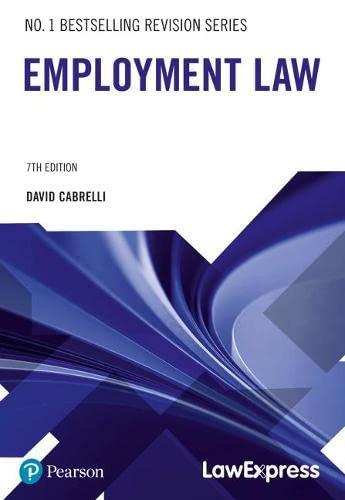Question
BUS-225: Legal Environment of Business the case summary Marriv. New York City Transit Authority (2013). Navigate to the threaded discussion, and respond to the following:
BUS-225:Legal Environment of Business
- the case summary "Marriv. New York City Transit Authority (2013)."
- Navigate to the threaded discussion, and respond to the following:
- explain the summary judgment concept.
- Summarize the relevant facts of Marri v. New York City Transit Authority (2013).
- Explain why you agree or disagree with the legal ruling in Marri v. New York City Transit Authority (2013).
Marri v New York City Tr. Auth.Annotate this Case
Marri v New York City Tr. Auth. 2013 NY Slip Op 03065 Decided on May 1, 2013 Appellate Division, Second Department Published by New York State Law Reporting Bureau pursuant to Judiciary Law 431. This opinion is uncorrected and subject to revision before publication in the Official Reports. Decided on May 1, 2013 SUPREME COURT OF THE STATE OF NEW YORKAPPELLATE DIVISION : SECOND JUDICIAL DEPARTMENT WILLIAM F. MASTRO, J.P. CHERYL E. CHAMBERS PLUMMER E. LOTT SANDRA L. SGROI, JJ. 2012-05317 (Index No. 16119/10) [*1]Vipulamma Marri, appellant, v New York City Transit Authority, respondent. Sim & Record, LLP, Bayside, N.Y. (Sang J. Sim of counsel), for appellant. DECISION & ORDER
In an action to recover damages for personal injuries, the plaintiff appeals from an order of the Supreme Court, Queens County (Gavrin, J.), dated April 12, 2012, which granted the defendant's motion for summary judgment dismissing the complaint.
ORDERED that the order is affirmed, without costs or disbursements.
The plaintiff was a passenger on the defendant's bus. She alleged that, as she was walking to a seat, the bus stopped short and she fell to the floor of the bus. After the plaintiff commenced this personal injury action against the defendant, the defendant moved for summary judgment dismissing the complaint. In support of its motion, the defendant relied upon the emergency doctrine and submitted the deposition testimony of the plaintiff and the bus driver. The bus driver testified that, while his bus was in the center lane of a roadway with three lanes in each direction, a sedan, without signaling, "popped out" of the right lane, which had become a lane for right turns only, and cut into the center lane, causing him to apply his brake in a "heavy" manner. The bus driver testified that his bus was proceeding at a rate of less than 30 miles per hour during the one-minute period prior to the accident. The Supreme Court granted the motion.
Through the emergency doctrine, the law recognizes " that those faced with a sudden and unexpected circumstance, not of their own making, that leaves them with little or no time for reflection or reasonably causes them to be so disturbed that they are compelled to make a quick decision without weighing alternative courses of conduct, may not be negligent if their actions are reasonable and prudent in the context of the emergency' (Bello v Transit Auth. of N.Y. City, 12 AD3d 58, 60; see Parastatidis v Holbrook Rental Ctr., Inc., 95 AD3d 975, 976)" (Lowhar-Lewis v Metropolitan Transp. Auth., 97 AD3d 728, 729).
"Although the existence of an emergency and the reasonableness of the response to it generally present issues of fact for purposes of application of the emergency doctrine (see Lonergan v Almo, 74 AD3d 902,903), those issues may in appropriate circumstances be determined as a matter of law" (Davis v Metropolitan Tr. Auth., 92 AD3d 825, 826).
Here, as in Miloscia v New York City Bd. of Educ. (70 AD3d 904, 905), the defendant established its prima facie entitlement to judgment as a matter of law by demonstrating that the [*2]actions of the bus driver in braking abruptly to avoid a collision with a car that had suddenly pulled out in front of him were reasonably prudent in an emergency situation not of his own making (see Villar v MTA Bus Co., 80 AD3d 602; Gonzalez v New York City Tr. Auth., 78 AD3d 1120). In opposition, the plaintiff's speculative and conclusory assertions did not raise a triable issue of fact (see Gonzalez v New York City Tr. Auth., 78 AD3d at 1121; see Lyons v Rumpler, 254 AD2d 261). Accordingly, the Supreme Court properly granted the defendant's motion for summary judgment dismissing the complaint.
The plaintiff's remaining contention, that the defendant should have been precluded from raising the emergency doctrine because it was not pleaded as an affirmative defense, is not properly before this Court (see Miloscia v New York City Bd. of Educ., 70 AD3d at 905). MASTRO, J.P., CHAMBERS, LOTT and SGROI, JJ., concur.
ENTER:
Aprilanne Agostino
Clerk of the Court
Step by Step Solution
There are 3 Steps involved in it
Step: 1

Get Instant Access to Expert-Tailored Solutions
See step-by-step solutions with expert insights and AI powered tools for academic success
Step: 2

Step: 3

Ace Your Homework with AI
Get the answers you need in no time with our AI-driven, step-by-step assistance
Get Started


